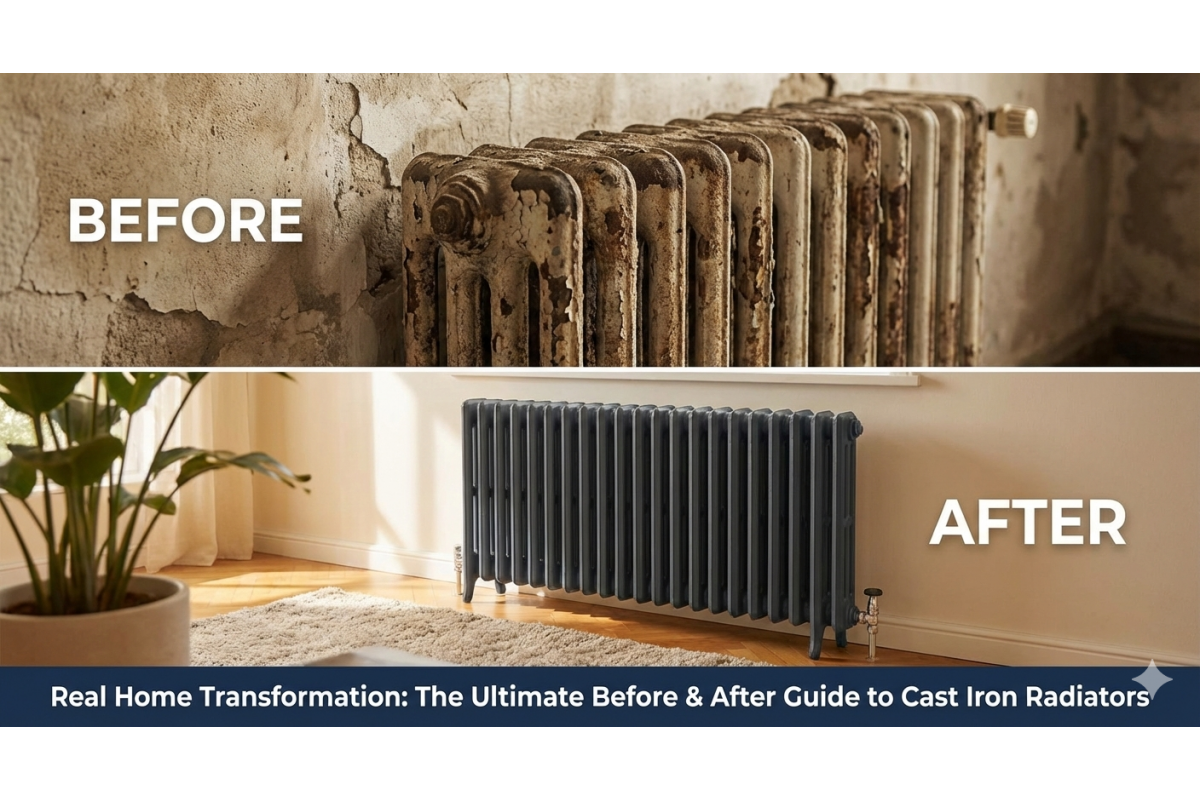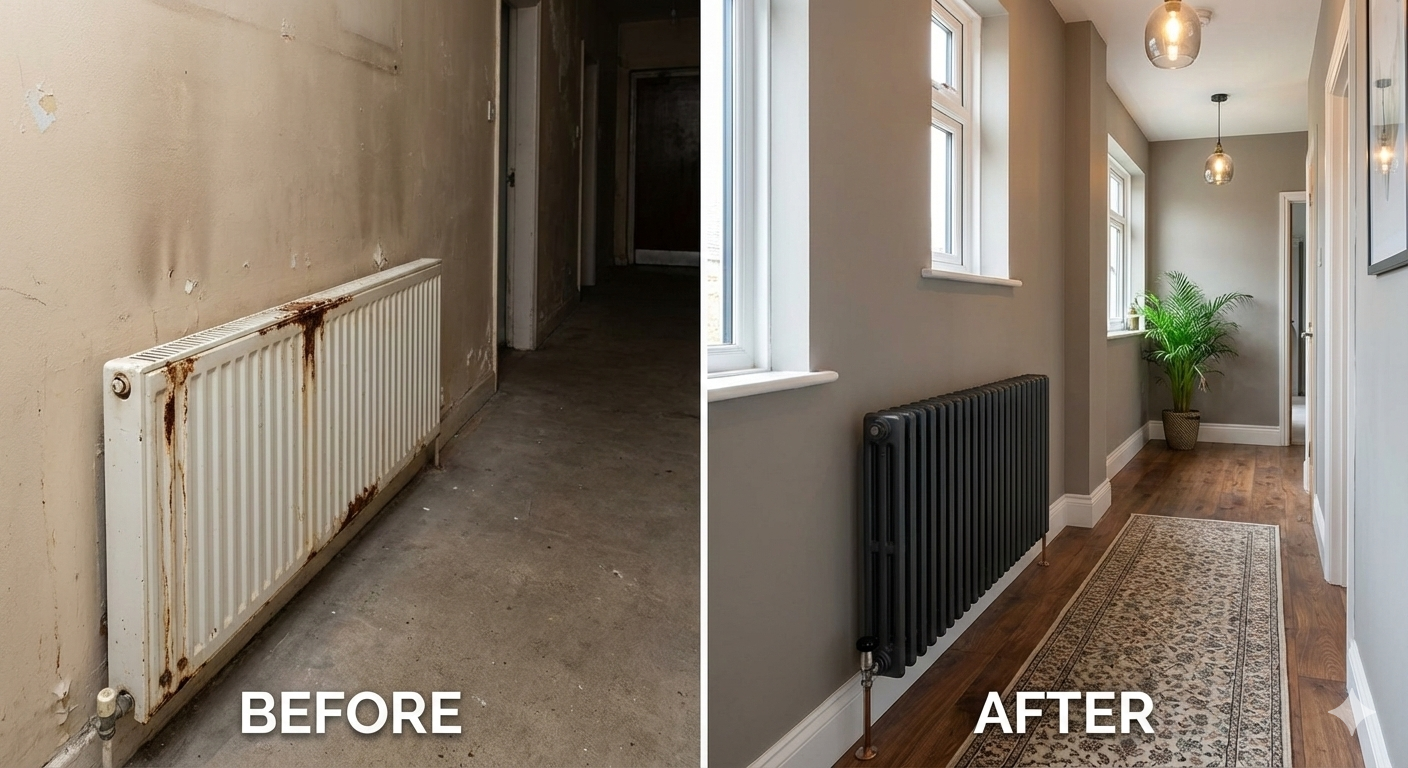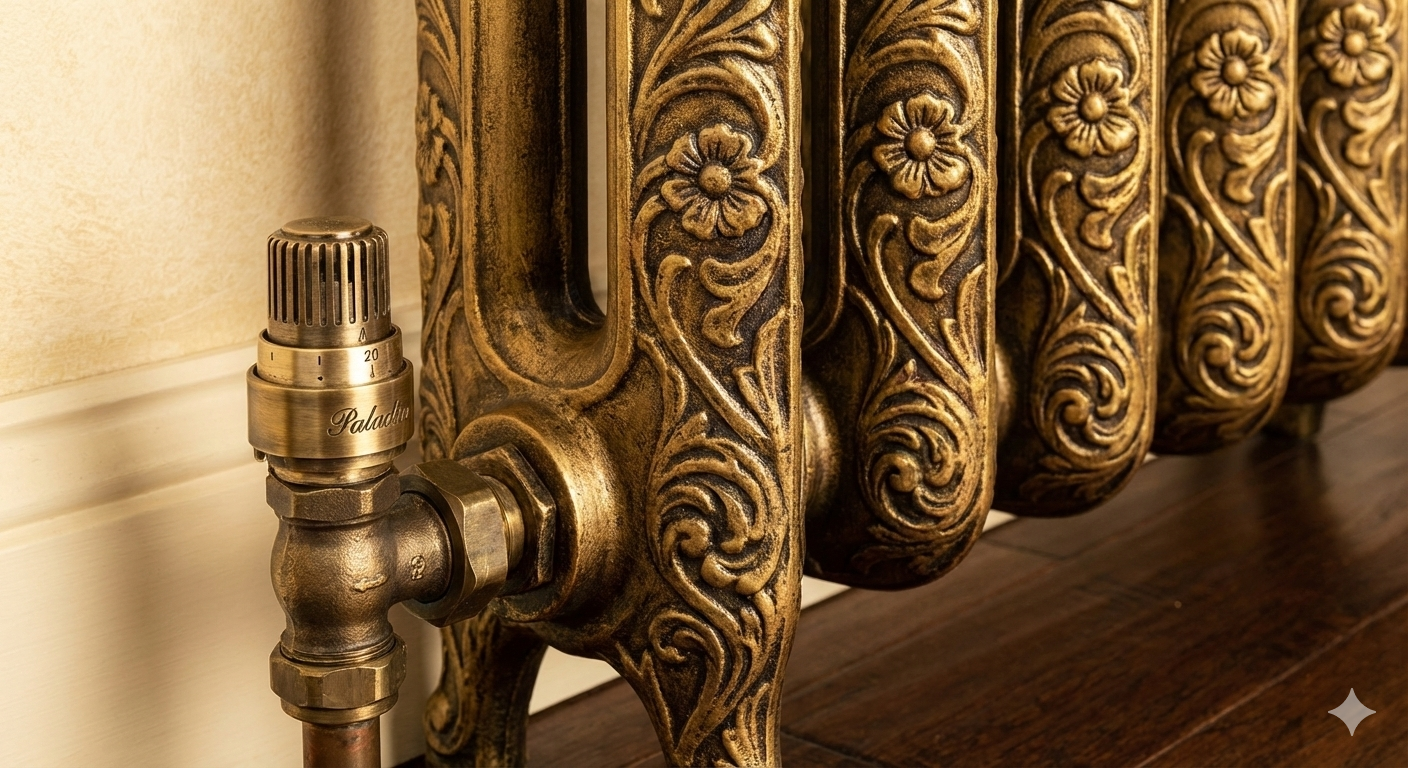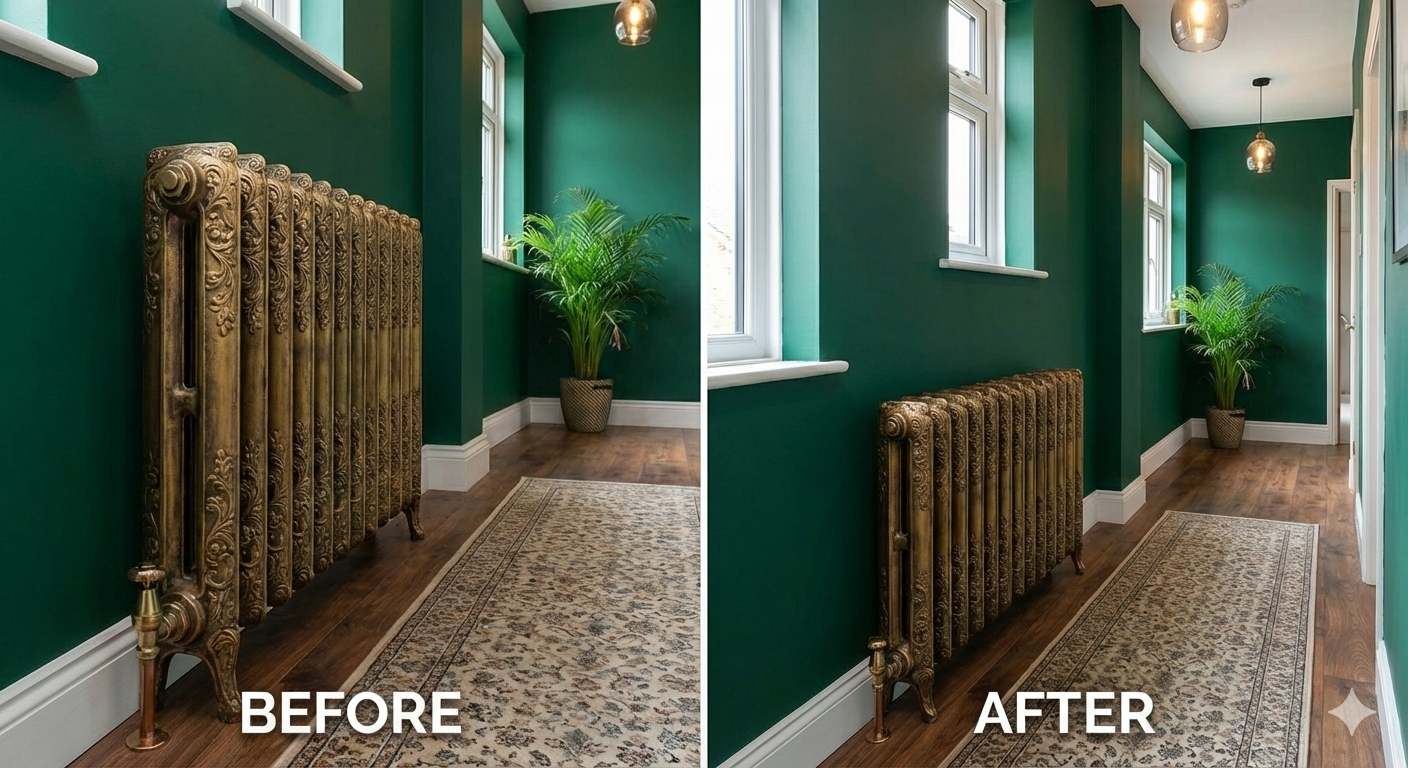Real Home Transformation: The Ultimate Before & After Guide to Cast Iron Radiators

By The Budget Radiators Heating Expert Team | Updated November 2025
Introduction: The Anti-Neutral Revolution
If 2024 was the year of Sad Beige and minimalism, 2025 is officially the era of the "Jewel Box" interior. Homeowners across the UK are trading safety for soul, embracing deep emeralds, mood-setting burgundies, and crucially textures that demand to be touched.
But in the rush to paint walls and reupholster armchairs, one massive surface area is often ignored: the heating. Nothing kills the vibe of a meticulously designed Edwardian renovation faster than a standard, glossy white panel radiator. It’s a modern scar on a vintage face.
In this extensive Real Home Before & After case study, we are going to walk you through a transformation that proves heating isn't just functional it is the jewellery of the room. We will analyze the decision-making process behind choosing a cast iron radiator, specifically the stunning Paladin Elizabethan, and provide you with an expert guide on how to replicate this look in your own home while keeping an eye on efficiency and budget.
The Before: A Cold, Forgotten Corridor
Let’s set the scene. The subject of our case study is a typical North London terrace, built circa 1910. The hallway often the most neglected space in British homes was functioning merely as a transit zone.
The Problems:
- Lack of Identity: The space felt transient and cold, with landlord beige walls and a rusting single-panel steel radiator that struggled to combat the draft from the front door.
- Inefficient Heating: Steel radiators heat up fast but cool down instantly. In a drafty hallway, this resulted in a "yo-yo" temperature effect, constantly demanding energy from the boiler without retaining warmth.
- Aesthetic Clash: The modern radiator fought against the original Victorian floorboards, creating visual friction.
The goal? To turn this corridor into a Jewel-Box Space a small area that packs a massive visual punch. The strategy involved dark, moody wallpaper, brass accents, and a heating solution that could act as the room's sculptural centerpiece.

The Solution: Why Cast Iron is the Hero We Need
The decision to swap steel for cast iron wasn't just about vanity; it was a decision rooted in building physics. To understand why this switch was crucial for our case study, we need to talk about Thermal Mass.
The Science of Staying Warm
A cast iron radiator is a dense storehouse of energy. Unlike aluminium or thin steel, which are "sprinters" (fast on, fast off), cast iron is a "marathon runner."
"Cast iron radiators take longer to reach temperature, but they continue to radiate a gentle, ambient warmth for hours after your central heating has switched off. This residual heat is perfect for older UK properties with lower insulation levels, as it stabilizes the room temperature."
For our hallway transformation, this meant the space would remain welcoming long after the thermostat clicked off in the evening, solving the "cold corridor" problem permanently.
The Product Choice: Paladin Elizabethan
For this renovation, the homeowners selected the Paladin Elizabethan Cast Iron Radiator. Here is why this specific model is a bestseller at Budget Radiators for period renovations:
1. The Profile
The Elizabethan features a classic 2-column design. In a narrow hallway, depth is a luxury you don't have. The 2-column profile is slim enough to hug the wall (projecting approximately 90-100mm) while still providing that chunky, substantial cast iron look. It is the perfect balance of spatial economy and vintage grandeur.
2. The "Antiqued Gold" Finish
This is where the "Jewel Box" aesthetic comes alive. A white radiator disappears; a black radiator recedes; but an Antiqued Gold radiator reflects.
In a dark room (painted in deep navy or forest green), the radiator catches the light from overhead pendants, glowing warmly. The "Antiqued" effect is crucial—it isn't a gaudy, shiny bling. It’s a hand-finished patina that looks like it has been in the house for 100 years, accumulating history. It bridges the gap between the bold wallpaper and the original timber floors.

The After: A Textural Masterpiece
The results speak for themselves. The hallway has transitioned from a cold thoroughfare into a destination. The Paladin Elizabethan sits against the dark wainscoting like a piece of sculpture.
Design Breakdown:
- Textural Contrast: The rough, tactile surface of the cast iron contrasts beautifully with the smooth, flat paint of the walls.
- Eclectic Harmony: The inclusion of Antique Brass Valves creates a cohesive metal story, matching the light switches and door handles.
- Visual Weight: The radiator anchors the space. Its heavy presence makes the small room feel grander and more permanent.

Expert Guide: How to Buy Cast Iron Radiators (Without Regrets)
Inspired by the case study? Before you rush to checkout, you need to navigate the technical specifications. Buying a cast iron radiator is different from buying a standard panel. Here is the checklist our experts at Budget Radiators swear by.
Step 1: Respect the BTU
We cannot stress this enough: Do not buy based on aesthetics alone. Cast iron radiates heat differently. You must calculate the heat requirement of your room.
Use our BTU Heating Calculator. You will need to input:
- Room dimensions (Height x Width x Length).
- Window type (Single glazing needs more power than double glazing).
- Sheltered vs. Exposed walls.
Pro Tip: If your chosen radiator is slightly under the required BTU output, consider sizing up to a taller model or adding more sections. It is always better to have too much heat (which you can turn down via TRVs) than too little.
Step 2: Valve Selection is Critical
A common error is pairing a £500 heritage radiator with cheap white plastic valves. It looks jarring.
- Thermostatic Radiator Valves (TRVs): These are essential for efficiency. They sense the air temperature and shut the radiator off when the room is warm. For cast iron, look for "Traditional" style TRVs with wooden or ceramic heads.
- Manual Valves: These are simple on/off taps. They are historically accurate but less efficient. Use them in bathrooms or rooms where the heating is always on.
- Matching Finishes: If your radiator is Gold, opt for Brass or Unlacquered Brass valves. If your radiator is Pewter or Black, try Chrome or Brushed Nickel valves.
Step 3: Wall Stays & Floor Support
Safety First: Cast iron radiators are incredibly heavy. A 10-section Elizabethan can weigh over 60kg. Because they are freestanding on feet, they can be tipped over if a child climbs on them or if they are knocked heavily.
Wall Stays are mandatory. These are small metal arms that anchor the radiator to the wall behind it. They don't take the weight (the floor does that), but they provide stability.
Flooring Note: If you have suspended timber floors, try to position the radiator feet directly over the joists. If that isn't possible, ensure your floorboards are in good condition. The weight is usually spread well, but for very large radiators (20+ sections), consult a builder.
Installation & Maintenance
Delivery Day
Unlike Amazon packages, these radiators arrive on pallets. They are kerbside delivery. You will need two strong people to lift the radiator into the house. Do not drag it cast iron feet can scratch floors, and dragging can strain the watertight seals between the sections.
The Static Duster Trick
Maintenance is surprisingly easy. Cast iron is robust. The only real enemy is dust, which can gather between the columns and act as an insulator, reducing heat output.
Expert Hack: Don't use a wet cloth inside the columns; it just smears the dust. Buy a cheap "static duster" or a goat-hair radiator brush. It attracts the dust magnetically and slides easily between the tight columns of the Elizabethan model.
Conclusion: Luxury within Reach
The "Before & After" of our North London case study proves that heating is a central pillar of interior design. By choosing a Paladin Elizabethan Cast Iron Radiator, the homeowners didn't just warm a hallway; they created a moment of joy in their daily routine.
At Budget Radiators, we believe this level of style shouldn't be exclusive to luxury budgets. We work directly with manufacturers to bring you premium cast iron models at competitive prices, backed by our Price Match Promise.
Ready to start your own transformation?
Don't let another winter pass with cold corridors and boring white panels.
Browse our Full Collection of Cast Iron Radiators
Have questions about sizing or finishes? Our team is ready to help. Drop a comment below or contact us directly!
